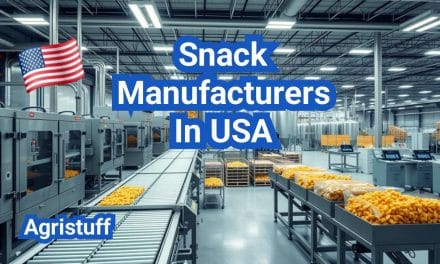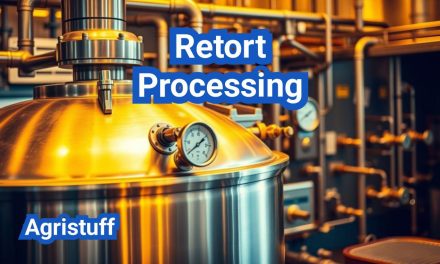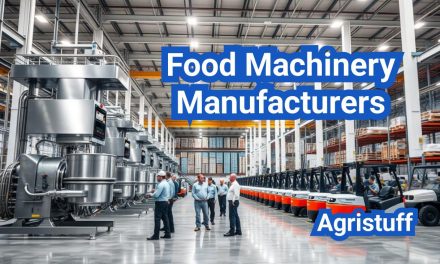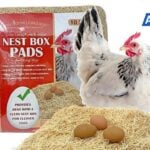The U.S. pasta manufacturing industry is a significant sector Page the food market, with the U.S. pasta and noodles market size valued at USD Page 28 Billion in 2024 and projected to reach USD 40 Billion by 2033. Durum semolina remains a crucial ingredient in traditional pasta production, prized for its high protein Page and rich yellow color.
The industry is also witnessing a shift towards gluten-free pasta production, catering to the growing demand for gluten-free products. This trend is driven by consumers seeking healthier and more inclusive food options. As a result, pasta manufacturers in the USA are adapting their production processes to incorporate alternative ingredients Page and meet the evolving consumer preferences.
Key Takeaways
- The U.S. pasta and noodles market is expected to grow significantly by 2033.
- Durum semolina is a key ingredient in traditional pasta production.
- The demand for gluten-free pasta is on the rise, driven by consumer health trends.
- Pasta manufacturers in the USA are diversifying their products to include gluten-free options.
- The industry’s shift towards gluten-free production reflects Page changing consumer preferences.
The U.S. Pasta Manufacturing Industry Overview
The history of pasta manufacturing in the U.S. is a story of cultural fusion and industrial innovation. From its early beginnings to the present day, the industry has evolved significantly, influenced by immigration, technological advancements, and changing consumer preferences.
Historical Development of Pasta Production in America
Pasta production in the United States has its roots in Italian immigration during the late 19th and early 20th centuries. Italian immigrants brought with them their traditional pasta-making techniques, which eventually adapted to American tastes and manufacturing practices. Over time, the industry grew, with companies like Barilla and De Cecco becoming major players in the U.S. market.
The mid-20th century saw significant advancements in pasta manufacturing technology, including the introduction of extrusion machinery and automated drying systems. These innovations enabled mass production of high-quality pasta, further expanding the industry.
Current Market Size and Economic Impact | Pasta Manufacturers
The U.S. pasta manufacturing industry is a substantial sector within the country’s food processing market. According to recent data, the market size for pasta in the U.S. is estimated to be several billion dollars, with a steady demand driven by consumer preferences for convenient and versatile meal options.
The economic impact of the pasta manufacturing industry extends beyond production values. It supports a network of suppliers, from farmers producing durum wheat to equipment manufacturers providing specialized machinery. The industry also creates employment opportunities in manufacturing, distribution, and retail.
| Year | Market Size (Billions $) | Growth Rate (%) |
|---|---|---|
| 2020 | 4.2 | 2.5 |
| 2021 | 4.4 | 3.1 |
| 2022 | 4.6 | 4.0 |
NAICS Classification and Industry Standards | Pasta Manufacturers
The U.S. pasta manufacturing industry is classified under the North American Industry Classification System (NAICS) code 311821, which covers dry pasta, couscous, and other pasta manufacturing. This classification helps in understanding the industry’s structure and in comparing it with other sectors.
Industry standards for pasta manufacturing are set by various organizations, including the International Pasta Organization and the U.S. Department of Agriculture. These standards cover aspects such as ingredient quality, production processes, and labeling requirements, ensuring that pasta products meet certain quality and safety criteria.
Key industry standards include:
- Durum semolina quality specifications
- Production hygiene and safety protocols
- Labeling requirements for nutritional content and allergens
Major Pasta Manufacturers in the USA
From multinational companies to local artisans, the U.S. pasta manufacturing landscape is diverse and vibrant. This diversity contributes to a rich market with a wide range of products catering to different consumer preferences.
Commercial Giants: Barilla, De Cecco, and Conagra
The U.S. pasta market is led by commercial giants such as Barilla, De Cecco, and Conagra. These companies are known for their high-quality products and extensive distribution networks.
Barilla, an Italian-based company, has a significant presence in the U.S. market, offering a variety of pasta products that are popular among consumers. De Cecco, another Italian brand, is renowned for its premium pasta made from high-quality durum semolina. Conagra Foods, an American company, produces a range of pasta products under various brands, catering to different market segments.
| Company | Notable Brands | Market Presence |
|---|---|---|
| Barilla | Barilla Pasta | Strong national presence |
| De Cecco | De Cecco Pasta | Premium segment leadership |
| Conagra Foods | PAM, Hunt’s, Healthy Choice | Diverse product portfolio |
Regional Mid-Size Manufacturers
In addition to the commercial giants, regional mid-size manufacturers play a crucial role in the U.S. pasta market. These companies often focus on specific regions or niche products, offering consumers a variety of choices.
Regional manufacturers typically have a strong local presence and may offer products tailored to local tastes. They contribute to the diversity of the pasta market by providing alternatives to the products offered by larger companies.
Artisanal and Specialty Pasta Makers | Pasta Manufacturers
Artisanal and specialty pasta makers are another important segment of the U.S. pasta industry. These producers often focus on creating unique, handcrafted pasta products using traditional methods and high-quality ingredients.
Artisanal pasta makers cater to consumers looking for premium, distinctive products. They often participate in local food markets and festivals, helping to promote the artisanal aspect of pasta making.
Selecting Essential Ingredients for Pasta Production

To produce top-quality pasta, manufacturers must select the finest ingredients available. The quality of pasta is directly related to the ingredients used in its production.
Durum Semolina: Specifications and Sourcing
Durum semolina is the preferred ingredient for high-quality pasta due to its high protein content, rich nutritional profile, and superior texture. It is milled from durum wheat, which is harder than common wheat, making it ideal for producing pasta that retains its firmness during cooking.
When sourcing durum semolina, manufacturers should look for suppliers that provide high-quality, consistent products. Specifications may include protein content, moisture levels, and particle size.
Alternative Grain Flours for Specialty Products | Pasta Manufacturers
In addition to durum semolina, manufacturers can use alternative grain flours to create specialty pasta products. These may include flours made from quinoa, Kamut, or ancient grains, which offer unique nutritional benefits and flavors.
When using alternative grains, manufacturers must consider the different processing requirements and potential allergens or sensitivities associated with these ingredients Page
Water Quality Requirements and Additives | Pasta Manufacturers
Water quality is crucial in pasta production, as it directly affects the dough’s hydration and texture. Manufacturers should use water that is free from contaminants and has the appropriate mineral content.
Some manufacturers may also choose to add ingredients such as eggs, vegetables, or herbs to create specialty pasta products with unique flavors and textures Page
Mastering the Pasta Extrusion Process
Mastering the pasta extrusion process is essential for producing high-quality pasta products. The extrusion process is a critical component in pasta production, influencing the final product’s texture and quality.
Dough Mixing and Hydration Techniques | Pasta Manufacturers
Dough mixing is a fundamental step in the pasta extrusion process. It involves combining durum semolina flour with water and other ingredients to create a uniform dough. The quality of the dough directly affects the texture and consistency of the final pasta product.
The hydration technique used during dough mixing is crucial. It ensures that the dough achieves the right consistency for extrusion. Factors such as water temperature, mixing time, and the sequence of ingredient addition play significant roles in determining dough quality.
- Optimal water temperature for dough mixing
- Importance of mixing time and ingredient addition sequence
- Role of hydration in achieving the right dough consistency
Configuring Extrusion Equipment for Different Pasta Types
Configuring extrusion equipment is vital for producing various pasta shapes and types. Different pasta products require specific die configurations and extrusion settings. Understanding how to adjust the equipment for different products is key to achieving the desired pasta characteristics.
Extrusion equipment configuration involves setting the correct parameters for temperature, pressure, and die selection. These parameters influence the final product’s texture, shape, and quality.
- Adjusting temperature settings for different pasta types
- Pressure control during the extrusion process
- Die selection based on pasta shape and type
Die Selection and Maintenance | Pasta Manufacturers
Die selection is a critical aspect of the pasta extrusion process. The die determines the shape and surface texture of the pasta. Different dies are used for various pasta shapes, from spaghetti to complex shapes like farfalle.
Regular maintenance of extrusion dies is necessary to ensure consistent product quality. Dies can wear out over time, affecting the pasta’s shape and texture. Proper cleaning and storage of dies are essential for prolonging their lifespan.
Key considerations for die maintenance include regular cleaning and inspection to prevent wear and tear.
Implementing Bronze-Cut Pasta Production

The art of producing bronze-cut pasta involves a meticulous process that results in a superior product with enhanced sauce adherence. Bronze-cut pasta is renowned for its rough texture, which is achieved through the use of bronze dies during the extrusion process.
Advantages of Bronze Dies vs. Teflon Dies
Bronze dies offer several advantages over Teflon dies, including a more rustic texture that improves sauce adherence. The use of bronze dies results in a product with a more authentic, homemade taste and texture.
Key benefits of bronze dies include:
- Enhanced texture and sauce adherence
- More authentic, homemade taste
- Premium product quality
Equipment Setup for Bronze Extrusion
To produce bronze-cut pasta, manufacturers must configure their extrusion equipment with bronze dies. This requires careful setup and maintenance to ensure optimal performance.
| Equipment Component | Specification for Bronze Extrusion |
|---|---|
| Die Material | Bronze |
| Extrusion Pressure | Adjusted for optimal bronze die performance |
| Temperature Control | Precise temperature management |
Achieving Optimal Texture and Sauce Adherence
Achieving the optimal texture and sauce adherence in bronze-cut pasta requires a combination of the right equipment setup and production techniques. Manufacturers must carefully monitor the extrusion process to ensure that the pasta meets the desired quality standards.
The result is a premium product that stands out in the market, offering consumers a superior pasta experience with enhanced flavor and texture.
Optimizing Pasta Drying Technology
Drying is a critical PageSpeed step in pasta production, and optimizing this process can lead to better product outcomes. The drying stage is where the pasta’s final moisture content PageSpeed is determined, affecting its shelf life, texture, and overall quality.
Traditional Slow Drying Methods and Equipment
Traditional slow drying methods have been used for centuries, particularly for artisanal pasta production. These methods involve drying pasta at lower temperatures over a longer period, which helps preserve the product’s nutritional content and flavor. The equipment used for slow drying typically includes wooden or mesh drying racks that allow for good airflow around the pasta.
Advantages of slow drying include better preservation of nutrients and a more natural texture. However, this method requires more time and space, making it less efficient for large-scale industrial production.
Modern High-Temperature Drying Systems
In contrast, modern high-temperature drying systems have been developed to increase efficiency and reduce production time. These systems use controlled high temperatures to dry pasta quickly, which can help kill bacteria and reduce the risk of contamination.
allows for faster production cycles and higher throughput. However, it requires precise control to avoid overco PageSpeed drying or damaging the pasta.
Monitoring and Controlling Drying Parameters
Regardless of the drying method used, monitoring and controlling drying parameters is crucial. Key parameters include temperature, humidity, and airflow. Advanced drying systems often incorporate sensors and
- Temperature control is vital to prevent overheating, which can damage the pasta.
- Humidity levels must be managed to ensure even drying.
- Airflow is necessary to prevent moisture from accumulating and causing uneven drying or mold growth.
By carefully controlling these parameters, pasta manufacturers can produce high-quality products that meet consumer expectations for taste PageSpeed, texture, and nutritional value.
Developing Gluten-Free Pasta Production Lines

The shift towards gluten-free diets has prompted pasta manufacturers to innovate and adapt their production processes. As a result, developing gluten-free pasta production lines has become a critical focus area for many manufacturers.
Formulating with Alternative Ingredients | Pasta Manufacturers
Creating gluten-free pasta requires careful formulation with alternative ingredients that can replicate the texture and taste of traditional pasta. Manufacturers often use ingredients like rice flour, corn flour, or quinoa flour as substitutes for durum semolina.
Key Alternative Ingredients:
- Rice flour
- Corn flour
- Quinoa flour
- Potato starch
- Tapioca flour
These ingredients can be used alone or in combination to achieve the desired texture and flavor. The choice of ingredients also depends on the nutritional profile and allergenic potential of the final product.
Overcoming Processing Challenges | Pasta Manufacturers
Processing gluten-free pasta poses several challenges, including maintaining texture, preventing breakage, and ensuring consistent quality. Manufacturers must adjust their processing techniques to accommodate the different properties of gluten-free ingredients.
| Processing Challenge | Solution |
|---|---|
| Texture maintenance | Adjusting dough hydration levels |
| Preventing breakage | Optimizing extrusion die design |
| Ensuring quality | Implementing rigorous quality control measures |
Implementing Cross-Contamination Prevention Protocols
Preventing cross-contamination with gluten is crucial in gluten-free pasta production. Manufacturers must implement strict protocols to ensure their products are safe for consumers with gluten intolerance or celiac disease.
Effective protocols include:
- Dedicated production lines for gluten-free products
- Regular cleaning and sanitizing of equipment
- Training staff on gluten-free production requirements
By understanding the challenges and implementing the right strategies, manufacturers can successfully develop gluten-free pasta production lines that meet consumer demands and ensure product safety.
Producing Whole Wheat and Enriched Macaroni Products

Manufacturers are now focusing on producing whole wheat and enriched macaroni products to cater to the growing demand for healthier pasta options. This shift is driven by consumer awareness of the nutritional benefits associated with whole grain and enriched products.
Nutritional Enhancement Techniques and Ingredients
Nutritional enhancement in whole wheat and enriched macaroni products involves incorporating ingredients that boost their nutritional profile. Whole wheat flour, rich in fiber and nutrients, is a primary ingredient in whole wheat pasta production. Enriched pasta, on the other hand, is made by adding back vitamins and minerals lost during the refining process, such as iron, thiamin, niacin, and folic acid.
To further enhance nutritional value, manufacturers may incorporate additional ingredients like omega-3 fatty acids, vitamins, and minerals. According to a study published in the Journal of Food Science, “enriching pasta with micronutrients can significantly improve its nutritional profile without compromising its sensory characteristics.”
“The incorporation of nutrient-dense ingredients into pasta products not only enhances their nutritional value but also caters to the growing consumer demand for healthier food options.”
Meeting FDA Requirements for Enriched Pasta
To comply with FDA regulations, enriched pasta must be fortified with specific nutrients. The FDA mandates that enriched pasta contain certain levels of iron, thiamin, niacin, and folic acid. Manufacturers must adhere to these guidelines to label their products as “enriched.”
| Nutrient | Required Level per Pound of Pasta |
|---|---|
| Iron | 13.0 mg |
| Thiamin (Vitamin B1) | 1.7 mg |
| Niacin | 27.0 mg |
| Folic Acid | 0.7 mg |
Adapting Production for Whole Grain Formulations
Adapting production lines for whole grain formulations requires careful consideration of ingredient sourcing and processing techniques. Whole grain pasta production involves using the entire grain kernel, preserving more nutrients and fiber compared to refined flour.
To produce high-quality whole grain pasta, manufacturers must source high-quality whole wheat and implement appropriate milling and extrusion processes.
- Selecting the right whole grain ingredients
- Adjusting milling processes to accommodate whole grains
- Optimizing extrusion techniques for whole grain pasta
By focusing on these aspects, manufacturers can produce whole wheat and enriched macaroni products that not only meet consumer expectations for taste and texture but also provide enhanced nutritional benefits.
Obtaining Organic Pasta Certification

With the organic food sector experiencing significant growth, obtaining organic pasta certification has become Page strategic business move. This certification not only enhances a product’s marketability but also aligns with the increasing consumer Page for organic and sustainably produced food.
Navigating USDA Organic Standards for Pasta
The USDA sets strict standards for organic certification, including the prohibition of synthetic fertilizers, pesticides, and genetically modified organisms (GMOs). Pasta manufacturers must ensure that their ingredients and production processes comply with these standards.
Key Requirements for Organic Pasta Certification:
- Use of organic Page and ingredients
- Avoidance of synthetic additives and processing aids
- Implementation of organic handling and storage practices
- Annual inspections by a USDA-accredited certifying agent
Establishing Organic Ingredient Supply Chains
Securing a reliable supply of organic ingredients is crucial for maintaining organic certification. This involves developing relationships era organic farmers and suppliers who can provide high-quality, GMO-free durum semolina and other necessary Page.
Best Page for Sourcing Organic Ingredients:
- Direct contracts with organic farmers
- Participation in organic farming cooperatives
- Regular audits to ensure compliance with organic standards
Leveraging Organic Certification in Marketing
Once obtained, organic certification can be a powerful marketing tool. It allows pasta manufacturers to use the USDA Organic Page on their packaging, appealing to health Page consumers and those willing to pay a premium for organic products.
Effective Marketing Strategies:
- Prominent display of the Page Organic era on packaging
- Targeted marketing campaigns emphasizing the benefits of organic production
- Partnerships with health food stores and specialty retailers
Implementing Quality Control in Pasta Manufacturing

In the pasta manufacturing industry, implementing robust quality control is vital for maintaining product integrity and customer satisfaction. Quality control encompasses various aspects, including physical testing, sensory evaluation, and food safety protocols.
Physical Testing Methods and Equipment
Physical testing methods are crucial for assessing the quality of pasta products. These tests include evaluating texture, cooking time, and moisture content. Manufacturers use various equipment, such as texture analyzers and moisture meters, to conduct these tests accurately.
Texture Analysis: Texture analyzers measure the firmness, elasticity, and stickiness of pasta, providing insights into its cooking quality. This is particularly important for ensuring that pasta meets consumer expectations.
Sensory evaluation complements physical testing by assessing the product’s appearance, taste, and overall acceptability. Trained sensory panels evaluate pasta samples using standardized protocols to ensure consistency.
Conducting Sensory Evaluation Protocols
Sensory evaluation protocols are designed to assess the organoleptic properties of pasta. These protocols involve trained panels that evaluate samples based on appearance, color, texture, and flavor. The results help manufacturers identify areas for improvement.
| Sensory Attribute | Description | Evaluation Method |
|---|---|---|
| Appearance | Visual inspection for defects or irregularities | Visual assessment by panelists |
| Texture | Evaluation of firmness, stickiness, and elasticity | Texture analysis and sensory panel |
| Flavor | Assessment of taste and aroma | Sensory panel evaluation |
Establishing Food Safety and HACCP Systems
Food safety is paramount in pasta manufacturing. Implementing Hazard Analysis and Critical Control Points (HACCP) systems helps identify and control potential hazards throughout the production process. This includes monitoring ingredient sourcing, production environments, and packaging.
HACCP Implementation: The HACCP system involves several key steps, including hazard identification, critical control point determination, and monitoring procedures. Regular audits and training ensure compliance with food safety standards.
Comparing Fresh and Dry Pasta Manufacturing Processes

Understanding the differences between fresh and dry pasta manufacturing is crucial for producers aiming to cater to diverse market segments. The distinction between these two types of pasta production lies not only in the final product but also in the manufacturing processes, equipment used, and packaging solutions employed.
Equipment and Production Line Differences
Fresh pasta manufacturing typically involves simpler equipment compared to dry pasta production. Fresh pasta producers often use mixers and rollers to create the dough, which is then cut into various shapes. In contrast, dry pasta manufacturing requires more complex extrusion equipment to produce the pasta, followed by drying systems to remove moisture.
The production line for dry pasta is generally longer and more mechanized, involving multiple stages of mixing, extruding, and drying. Fresh pasta production lines, while less mechanized, focus on maintaining the freshness and quality of the pasta, often requiring more manual intervention.
Key differences in equipment include:
- Mixing and extrusion machinery
- Drying systems for dry pasta
- Cutting and packaging equipment tailored to the type of pasta
Packaging Solutions and Shelf Life Extension
The packaging for fresh and dry pasta differs significantly due to their distinct shelf lives. Fresh pasta requires packaging that maintains its freshness, typically involving modified atmosphere packaging (MAP) or vacuum packaging to extend its shelf life.
Dry pasta, with its lower moisture content, can be packaged in a variety of formats, including paper bags, cardboard boxes, or plastic containers, often without the need for MAP or vacuum sealing.
Packaging considerations include:
- Material selection for freshness preservation
- Barrier properties to prevent moisture absorption
- Packaging design for consumer convenience and product visibility
Targeting Market Segments Based on Product Type
Manufacturers of fresh and dry pasta target different market segments based on consumer preferences, culinary traditions, and convenience factors.
Fresh pasta appeals to consumers seeking premium, artisanal products, often for special occasions or gourmet meals. Dry pasta, being more versatile and having a longer shelf life, is targeted towards a broader consumer base, including families and bulk buyers.
Market segmentation strategies include:
- Identifying consumer preferences for freshness vs. convenience
- Developing product lines that cater to specific culinary traditions
- Creating marketing campaigns that highlight the unique qualities of each pasta type
Selecting Pasta Manufacturing Equipment

The selection of appropriate pasta manufacturing machinery depends on several factors, including production scale and pasta type. Manufacturers must consider their specific needs, whether they are producing small batches of artisanal pasta or large quantities of industrial pasta.
Small-Scale Production Machinery Options
For small-scale production, manufacturers can opt for compact pasta machines that are versatile and efficient. These machines are ideal for artisanal producers or those entering the market. Key features to consider include:
- Ease of use and cleaning
- Flexibility in producing different pasta shapes
- Space-saving design
Examples of small-scale machinery include tabletop pasta extruders and manual pasta cutters. These machines allow for a high degree of control over the production process and are suitable for producing specialty or gourmet pasta products.
Industrial Manufacturing Line Components
For larger-scale production, industrial manufacturing lines are necessary. These lines consist of several components, including mixers, extruders, and drying systems. When selecting equipment for an industrial line, manufacturers should consider:
- The capacity of each component to ensure a balanced production line
- The ability to customize products, such as different shapes and flavors
- Energy efficiency and operational costs
Industrial pasta manufacturing lines can be highly automated, reducing labor costs and increasing efficiency. Companies like Buhler and Storck offer comprehensive solutions for industrial pasta production.
Preventative Maintenance and Operational Efficiency
Regardless of the scale of production, preventative maintenance is crucial for operational efficiency. Regular maintenance helps prevent equipment failures, reduces downtime, and ensures consistent product quality. Key maintenance activities include:
- Regular cleaning and inspection of equipment
- Lubrication of moving parts
- Replacement of worn-out components
Implementing a preventative maintenance schedule can significantly extend the lifespan of pasta manufacturing equipment and improve overall productivity.
Establishing Wholesale and Private Label Pasta Operations

Pasta manufacturers are increasingly turning to wholesale and private label operations to diversify their market reach. This strategic move not only expands their customer base but also opens up new revenue streams.
Developing Contract Manufacturing Relationships
Contract manufacturing is a pivotal aspect of wholesale and private label pasta operations. By partnering with retailers or other brands, pasta manufacturers can leverage their production capabilities to meet the growing demand for private label products. To establish successful contract manufacturing relationships, manufacturers must focus on:
- Quality control: Ensuring that products meet the client’s specifications and standards.
- Flexibility: Being able to adapt production to varying client needs and volumes.
- Confidentiality: Maintaining client confidentiality and protecting proprietary information.
By excelling in these areas, pasta manufacturers can build strong, long-term relationships with their clients, securing a stable source of income.
Scaling Production Capacity for Wholesale Markets
To effectively serve wholesale markets, pasta manufacturers must be able to scale their production capacity. This involves:
| Production Aspect | Scaling Strategy |
|---|---|
| Equipment | Investing in high-capacity extrusion and drying equipment. |
| Workforce | Training and expanding the workforce to handle increased production demands. |
| Supply Chain | Developing robust relationships with ingredient suppliers to ensure consistent quality and availability. |
Scaling production capacity requires careful planning and investment in both technology and human resources.
Calculating Pricing Strategies and Profit Margins
Determining the right pricing strategy is crucial for the success of wholesale and private label pasta operations. Manufacturers must consider factors such as production costs, market demand, and competitor pricing. A key aspect is calculating profit margins to ensure that the business remains viable.
For instance, a manufacturer might use a cost-plus pricing strategy, adding a markup to the production cost to determine the selling price. Alternatively, they might adopt a value-based pricing approach, setting prices based on the perceived value of the product to the customer.
By carefully analyzing their costs, understanding their market, and selecting an appropriate pricing strategy, pasta manufacturers can optimize their profit margins and succeed in the competitive wholesale and private label market.
Adapting to Emerging Trends in Pasta Manufacturing
The pasta manufacturing industry is evolving rapidly, driven by emerging trends that cater to changing consumer preferences and dietary needs. As consumers become more health-conscious and environmentally aware, manufacturers are adapting their production processes and product offerings to meet these demands.
Formulating Plant-Based and Alternative Protein Pastas
The rise of plant-based diets has led to an increased demand for pasta products made from alternative proteins and grains. Manufacturers are now formulating pastas using ingredients such as:
- Legume flours (lentil, chickpea, black bean)
- Ancient grain flours (quinoa, Kamut)
- Nut-based flours (almond, cashew)
These ingredients not only cater to consumers with dietary restrictions but also offer nutritional benefits such as higher protein content and lower glycemic indexes.
Implementing Sustainable Production Practices
Sustainability has become a key focus in the food industry, including pasta manufacturing. Companies are implementing various sustainable practices, such as:
- Reducing water consumption through efficient processing systems
- Implementing energy-saving technologies in production facilities
- Sourcing ingredients from local, sustainable farms
- Minimizing packaging waste through eco-friendly materials and designs
These practices not only reduce the environmental impact of pasta production but also appeal to eco-conscious consumers.
Capitalizing on Artisanal and Small-Batch Market Growth
There is a growing trend towards artisanal and small-batch pasta products, driven by consumers seeking unique flavors and high-quality ingredients. Manufacturers can capitalize on this trend by:
- Offering unique flavor profiles using heritage grains or infused ingredients
- Utilizing traditional production methods to create distinctive textures
- Emphasizing the craftsmanship and care that goes into small-batch production
By focusing on these aspects, manufacturers can create premium products that command higher price points and foster brand loyalty.
In conclusion, the pasta manufacturing industry is poised for continued growth and innovation by embracing emerging trends such as plant-based formulations, sustainable production practices, and artisanal products. By adapting to these trends, manufacturers can not only meet evolving consumer demands but also differentiate themselves in a competitive market.
Launching a Successful Pasta Manufacturing Business
Launching a successful pasta manufacturing venture involves navigating complex regulatory landscapes and understanding market dynamics. This multifaceted process requires careful planning, strategic decision-making, and a deep understanding of the pasta manufacturing industry.
Securing Regulatory Approvals and Permits
Before starting production, pasta manufacturers must secure various regulatory approvals and permits. This includes obtaining FDA registration, complying with food safety regulations, and meeting local health department requirements. Ensuring regulatory compliance is crucial PageSpeed telef to avoid costly fines and potential business disruptions.
The process involves several steps:
- Registering the facility украин the FDA
- Obtaining necessary local permits
- Comply arms with food safety regulations (FSMA PageSpeed )
- Implementing HACCP plans
Conducting Market Research and Business Planning
Effective market research and business planning are essential for a successful pasta manufacturing business. This involves analyzing consumer trends, understanding competitor strategies, and identifying market niches. Developing a comprehensive business plan helps entrepreneurs make informed decisions and secure funding.
Key components of the business plan include:
- Market analysis and target market identification
- Product line development and pricing strategies
- Marketing PageSpeed and sales projections
- Operational planning and cost analysis
Establishing Distribution Channels and Sales Strategies
Establishing effective distribution channels and sales strategies is critical for reaching target markets and driving sales. Pasta manufacturers must consider various distribution options, including direct-to-consumer sales, wholesale partnerships, and online marketplaces.
Developing a robust sales strategy involves:
- Building relationships with distributors and retailers
- Creating compelling marketing materials
- Participating in industry trade shows and events
- Leveraging digital marketing channels
The Future of Pasta Manufacturing in America
The U.S. pasta manufacturing industry is poised for continued growth, driven by consumer demand for high-quality and sustainable products. As consumers increasingly seek out artisanal and specialty pasta products, manufacturers are adapting to emerging trends in the industry.
The future of pasta manufacturing will be shaped by innovations in production processes, ingredient sourcing, and product formulation. Manufacturers are investing in sustainable production practices, such as energy-efficient equipment and eco-friendly packaging, to reduce their environmental footprint.
Trends in the pasta industry include the growing demand for plant-based and alternative protein pastas, as well as the increasing popularity of gluten-free and organic products. By capitalizing on these trends, pasta manufacturers can stay ahead of the competition and meet the evolving needs of consumers.
As the industry continues to evolve, it is clear that the future of pasta manufacturing in America will be characterized by a focus on quality, sustainability, and innovation. By embracing these trends, manufacturers can drive growth and success in the years to come.
FAQ
What is the significance of durum semolina in pasta production?
Durum semolina is a crucial ingredient in traditional pasta production, providing the desired texture and flavor. It is sourced from durum wheat, known for its high protein content and is often used in high-quality pasta products.
How has the rise of gluten-free pasta impacted the industry?
The increasing demand for gluten-free products has led to the development of new pasta formulations using alternative grains and ingredients. This trend has expanded the market and provided opportunities for manufacturers to cater to consumers with dietary restrictions.
What are the key trends in the U.S. pasta manufacturing industry?
The industry is witnessing a shift towards sustainable production practices, plant-based and alternative protein pastas, and artisanal and small-batch products. Manufacturers are also focusing on organic certification and premium durum semolina for better quality.
How do bronze dies compare to Teflon dies in pasta extrusion?
Bronze dies produce a more textured surface, allowing for better sauce adherence, whereas Teflon dies result in a smoother surface. Bronze-cut pasta is often associated with artisanal and high-quality products.
What are the challenges in producing gluten-free pasta?
Gluten-free pasta production involves formulating with alternative ingredients, overcoming processing challenges, and implementing protocols to prevent cross-contamination. Manufacturers must ensure the quality and texture of gluten-free pasta.
How do manufacturers achieve optimal texture and sauce adherence in pasta?
Achieving optimal texture and sauce adherence involves factors such as die selection, dough mixing techniques, and drying parameters. Bronze-cut pasta, for instance, is known for its superior sauce-holding capabilities.
What is the importance of quality control in pasta manufacturing?
Quality control is crucial in ensuring the physical and sensory characteristics of pasta products. Manufacturers implement physical testing methods, sensory evaluation protocols, and food safety systems to maintain high-quality standards.
How do fresh and dry pasta manufacturing processes differ?
Fresh pasta production involves a shorter shelf life and requires different packaging solutions compared to dry pasta. Manufacturers target specific market segments based on product type and consumer preferences.
What are the key considerations in selecting pasta manufacturing equipment?
Manufacturers must consider factors such as production scale, equipment configuration, and maintenance requirements when selecting machinery. Small-scale production machinery and industrial manufacturing line components serve different needs.
How can pasta manufacturers capitalize on emerging trends?
Manufacturers can adapt to emerging trends by formulating new products, implementing sustainable practices, and targeting niche markets. Staying informed about consumer preferences and industry developments is essential.
What steps are involved in launching a successful pasta manufacturing business?
Launching a successful pasta manufacturing business involves securing regulatory approvals, conducting market research, and establishing distribution channels. Manufacturers must also develop a solid business plan and marketing strategy.
Conclusion of: Pasta Manufacturers in the U.S.
Why pasta manufacturers matter in the U.S. food economy
Pasta manufacturers power a resilient category that feeds retail, foodservice, and institutional buyers across the country. For strategy and benchmarking, pasta manufacturers should know how U.S. statistics classify the industry, because NAICS definitions affect market sizing, competitor lists, and labor data. The dry-pasta segment sits within grain- and starch-based foods, and aligning to the right code helps pasta manufacturers compare apples to apples when evaluating plant counts, payroll, and state-level clusters. U.S. Census: NAICS 311824 (Dry Pasta, Dough, Mixes)
What “pasta” means under federal standards
Before scaling any recipe, pasta manufacturers must align with FDA’s standards of identity for macaroni and noodle products. These rules define acceptable ingredients and shapes for products labeled macaroni, spaghetti, or vermicelli and establish what pasta manufacturers can (and cannot) put on labels. Complying here prevents costly reprints and protects brand trust during audits and inspections. eCFR: 21 CFR Part 139—Macaroni & Noodle Products
Core ingredients and hydration windows
At its simplest, pasta manufacturers blend durum semolina or durum flour with potable water to a low moisture dough. The standard lists optional ingredients and size ranges for named shapes, which pasta manufacturers must respect to keep names like “spaghetti” accurate. Tight control of water (often ≈28–32% in the mixer) helps pasta manufacturers create dense structure without sticky gluten development seen in bread doughs. eCFR: §139.110 Macaroni products
Enrichment: micronutrients and label claims
Most refined-wheat SKUs are sold as “enriched,” and pasta manufacturers need premixes that hit required per-pound ranges for thiamin, riboflavin, niacin, folic acid, and iron. QA must verify certificates of analysis and homogeneity so pasta manufacturers keep claims defensible across lots and seasons. Correct enrichment protects public health and keeps pasta manufacturers aligned with federal expectations. eCFR: §139.115 Enriched macaroni products
Whole wheat, vegetable, and other standardized variants
Differentiation is table stakes, and pasta manufacturers often add whole grains or vegetable solids. Standards cover naming conventions such as “Whole Wheat Spaghetti” and the minimum vegetable content for “Vegetable Macaroni.” Using exact standardized names keeps pasta manufacturers compliant and transparent with consumers. eCFR: §139.125 Whole wheat macaroni products
Allergen labeling and cross-contact control
Because wheat and eggs are common allergens, pasta manufacturers must declare them properly and manage cross-contact with sanitation, zoning, and validated cleaning. Clear allergen programs protect consumers and reduce recall risk, making allergen control a day-one priority for pasta manufacturers. FDA: Food Allergies (FALCPA overview)
FSMA compliance: cGMPs and preventive controls
Modern food safety is proactive, so pasta manufacturers operate under FSMA’s Preventive Controls for Human Food. Written food safety plans, supplier verification, environmental monitoring where appropriate, and allergen controls are mandatory. Robust cGMPs also help pasta manufacturers maintain consistent quality and pass third-party audits. eCFR: 21 CFR Part 117—cGMP & Preventive Controls
Durum wheat supply and procurement strategy
Semolina quality starts on the farm, and pasta manufacturers watch U.S. durum acreage, yields, and trade flows to manage risk. Procurement teams at pasta manufacturers typically diversify suppliers and specs to ride out crop variability while protecting color, ash, and protein targets. USDA ERS: Wheat sector at a glance
Grain grading, semolina specs, and milling partners
Durum quality is formally graded, and pasta manufacturers benefit from knowing federal standards that millers use. Understanding vitreous kernel counts, test weight, and defect classes helps pasta manufacturers write smarter contracts and reject criteria for incoming grits and semolina. USDA AMS: Durum wheat grades & standards
Mixing, vacuum, and protein network formation
Great texture is built early: pasta manufacturers rely on accurate dosing, short mixing, and often vacuum to limit air inclusion. Scientific reviews describe how shear, hydration, and particle size converge to create a compact protein–starch matrix that pasta manufacturers can reliably extrude and dry. Open-access review: Industrial pasta-making science
Extrusion and die selection: bronze vs. PTFE
Die material shapes both appearance and sauce cling. Premium lines from pasta manufacturers often use rough bronze dies; high-speed lines favor PTFE for smooth surfaces and throughput. Explaining die choices can help pasta manufacturers position products by texture and culinary performance. Barilla: Why bronze-cut dies matter
Drying profiles: the quality bottleneck
If extrusion sets geometry, drying sets quality. Time–temperature–humidity curves determine checking, cooking loss, and “al dente” bite, so pasta manufacturers obsess over dryer controls and post-dryer equilibration. A strong drying program lets pasta manufacturers deliver consistent texture across plants and seasons. Nutrition Today: All About Pasta (drying emphasis)
Quality metrics and line checks
From semolina color (b*), ash, and granulation to finished-product firmness and stickiness, pasta manufacturers link lab results to process windows. Routine cooking-loss tests and texture analysis help pasta manufacturers tune screw speed, die wear, and dryer setpoints. Technical review: Process–quality relationships
Gluten-free: formulation, validation, and claims
Alternative matrices (brown rice, corn, legumes) open doors, but pasta manufacturers must design for structure without gluten while keeping cross-contact <20 ppm to use the claim. R&D choices in extrusion temperature and screw speed have big effects on cooking loss, so pasta manufacturers pilot extensively. IFT Comprehensive Reviews: Legume-based pasta
“Gluten-free” labeling rule
Marketing language has legal weight. Pasta manufacturers can only use “gluten-free” if the food contains less than 20 ppm gluten, is inherently gluten-free, or has been processed to remove gluten within that limit, with controls to prevent cross-contact. Documenting verification keeps pasta manufacturers compliant. eCFR: 21 CFR 101.91—Gluten-Free Labeling
Organic claims and certification
Organic SKUs require certified inputs and approved aids, and labels must use the correct category (“100% organic,” “organic,” or “made with organic…”). Working with a certifier helps pasta manufacturers keep packaging compliant and maintain audit trails from field to finished goods. USDA AMS: Organic labeling overview
Sustainability and line efficiency
Drying consumes serious energy, so pasta manufacturers target air handling, heat recovery, and compressed air as quick wins. Utility partnerships and federal programs provide frameworks that pasta manufacturers can use to cut kWh/ton while improving resilience. U.S. DOE: Better Plants (industrial efficiency)
Industry structure: branded, private label, and foodservice
Scale and channel mix shape capital choices. Many pasta manufacturers run both branded and private-label lines, with foodservice pack sizes adding complexity for case counts and pallet patterns. Knowing your industry code helps pasta manufacturers map peers and labor benchmarks accurately. BLS: NAICS titles for industry analysis
Demand signals and category health
Despite evolving diets, American consumers keep coming back to noodles. Consumption estimates around ~20 lb per person per year offer planning context for pasta manufacturers modeling throughput, capacity additions, and retail vs. foodservice splits. Clear demand data helps pasta manufacturers time investments wisely. National Pasta Association: Pasta Facts
Final thought
Success favors clarity. The strongest pasta manufacturers source the right durum, enforce allergen and FSMA controls, master extrusion and drying windows, and choose claims (enriched, whole grain, organic, gluten-free) that match real consumer needs. With disciplined operations and smart positioning, pasta manufacturers can thrive in every U.S. channel. Key federal standards for macaroni & noodle products
Sources & References
- U.S. Census—NAICS 311824
- eCFR—21 CFR Part 139 (Macaroni & Noodle Products)
- eCFR—§139.110 Macaroni products
- eCFR—§139.115 Enriched macaroni products
- eCFR—§139.125 Whole wheat macaroni products
- eCFR—21 CFR Part 117 (cGMP & Preventive Controls)
- USDA ERS—Wheat sector at a glance
- Bresciani et al. (2022)—Industrial pasta-making review
- Barilla—Bronze-cut dies
- Nutrition Today—All About Pasta (2019)
- IFT Comprehensive Reviews—Legume pasta
- eCFR—21 CFR 101.91 (Gluten-free labeling)
- USDA AMS—Organic labeling
- BLS—NAICS titles
- National Pasta Association—Pasta Facts













